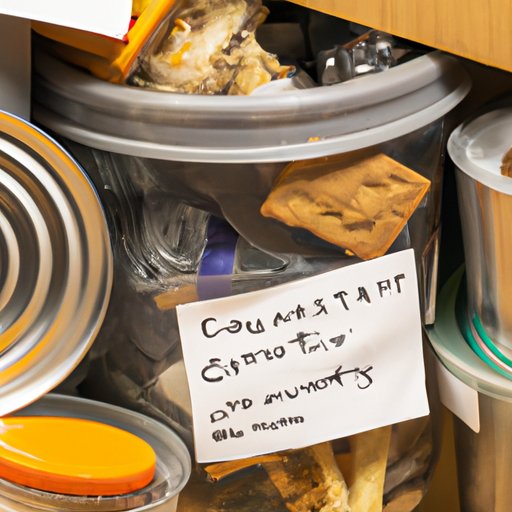Introduction
Cross-contamination is the transfer of harmful microorganisms from one object or surface to another, leading to the spread of disease-causing bacteria and the risk of foodborne illnesses. When it comes to food storage practices, it is crucial to understand and prevent cross-contamination to ensure food safety and avoid potential health hazards.
Labeling and Organizing Food Items in Storage Areas
The first step in preventing cross-contamination in storage is to properly label and organize food items. Labeling food with the date of purchase and expiration, as well as the type of food, will ensure that food is consumed before it spoils. Organizing foods by category will also prevent cross-contamination.
Benefits of labeling and organizing
Proper labeling and organizing can prevent waste and minimize the risk of contamination. Foods that are not properly labeled and organized may be forgotten in the back of the pantry or refrigerator, making them susceptible to spoilage, which can lead to the production of harmful bacteria and toxins.
Proper labeling techniques
When labeling food items, use a permanent marker or a label maker to ensure that labels do not smear or fall off. Be sure to include the date of purchase and expiration, as well as the type of food, to ensure that the food is properly stored and consumed before it spoils.
Organizing tips
Organizing food items by category, such as fruits, vegetables, dairy, and meats, can prevent cross-contamination. Keep raw meats on the bottom shelf of the refrigerator and use separate containers for different types of food, such as produce, dairy, and meats. This will reduce the risk of spreading bacteria and foodborne illnesses.
Potential Sources of Cross-Contamination in Storage
It is essential to understand what types of food can be hazardous and lead to the spread of bacteria and foodborne illnesses. Here are some potential sources of cross-contamination:
Raw meats
Raw meats, poultry, and seafood carry harmful bacteria such as Salmonella, E. coli, and Listeria. It is important to store raw meats properly by keeping them on the bottom shelf of the refrigerator, away from foods that are ready-to-eat. Use separate containers for raw meats and cooked meats, as well as separate cutting boards and utensils.
Dairy products
Dairy products such as milk, cheese, and yogurt are high in protein and can be a breeding ground for bacteria. Avoid storing dairy products in the refrigerator door as they are exposed to temperature fluctuations from frequent opening and closing. Instead, store dairy products in the main compartment of the refrigerator.
Vegetables
Vegetables can carry harmful bacteria such as E. coli and Salmonella. Store vegetables in the refrigerator and use separate containers for raw and cooked vegetables. Wash vegetables thoroughly before preparation to remove any dirt or bacteria.
Identifying potential risks
To identify potential risks of cross-contamination, it is important to keep track of the flow of food in the kitchen, from storage to preparation to cooking. Identify any potential sources of cross-contamination, such as cutting boards and utensils that have been used with raw meats, and sanitize them before using them again.
Risks of Using the Same Storage Containers/Surfaces
Using the same storage containers or surfaces can increase the risk of cross-contact and contamination.
Cross-contact risk
Cross-contact occurs when a food item touches another food item and transfers allergens or harmful bacteria between them. An example of cross-contact is using the same cutting board for raw meat and vegetables without cleaning it in between.
Explanation of contamination risk
Contamination occurs when harmful bacteria are transferred from one object or surface to another. This can happen during storage when storing different foods together or using the same container without cleaning it in between uses.
Importance of avoiding cross-contact
Avoiding cross-contact and contamination is essential to food safety. It is important to use separate containers and utensils for raw and cooked foods, wash reusable containers thoroughly, and sanitize surfaces before and after use.
Tips for Preventing Cross-Contamination During Storage
Here are some tips for preventing cross-contamination during storage:
Use of separate containers
Use separate containers for raw and cooked foods, and label them accordingly. This will reduce the risk of spreading harmful bacteria from one food item to another.
Wrapping or covering items
Wrap or cover foods with plastic wrap or aluminum foil to prevent contamination. This will also prevent cross-contact between different foods.
Cleaning storage areas regularly
Regularly clean storage areas, such as refrigerators and pantries, to prevent the buildup of harmful bacteria. This will reduce the risk of cross-contamination during storage.
Best food storage practices
Besides using separate containers and regularly cleaning storage areas, proper food storage practices include storing food at the correct temperature and using foods before they expire.
Consequences of Cross-Contamination
There are serious consequences to cross-contamination that can affect both the health of individuals and businesses:
Foodborne illnesses
Cross-contamination can lead to the spread of harmful bacteria that can cause food poisoning. Symptoms of foodborne illnesses include cramps, diarrhea, vomiting, and fever.
Impact on food safety regulations
Businesses that do not follow proper food storage and handling practices can be held liable for foodborne illnesses and face penalties/fines. Following proper storage practices and food safety regulations is essential for businesses to avoid legal consequences and ensure food safety.
Importance of taking action
It is important to take action and implement proper storage practices to prevent cross-contamination. By doing so, you can ensure food safety, prevent foodborne illnesses, and comply with food safety regulations.
Conclusion
Cross-contamination can be a serious issue in food storage practices. By properly labeling and organizing food items, identifying potential sources of cross-contamination, avoiding cross-contact and contamination, and regularly cleaning storage areas, you can prevent the spread of harmful bacteria and ensure food safety. Implementing proper practices will not only keep individuals healthy but also businesses compliant with food safety regulations.
